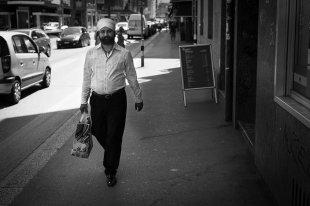Immigrants Across America are Now Being Forced to Ask Themselves a Very Ugly Question

Image Courtesy: gato-gato-gato / Flickr
On February 22, Adam Purinton was at Austin’s Bar and Grill when he began to argue with two Indian men.
“Get out of my country,” Purinton said to the two men, Srinivas Kuchibhotla, 32, and Alok Madasani, 32, both tech workers at the multinational technology firm Garmin. Purinton began to yell racist slurs at the men, got out his gun and began to shoot. A bystander, Ian Grillot, tried to intervene and was shot through his chest and hand.
Kuchibhotla died, while Madasani survived his wounds. Grillot also survived. “I was just doing what anyone should have done for another human being,” he said from his hospital bed, where he was recovering from a vertebral fracture.
A week later, on March 2, Harnish Patel was shot and killed just outside his home in the quiet town of Lancaster, South Carolina. Patel, 43, ran a Speed Mart convenience store and was known as a popular employer as well as a kind man. While the FBI has decided to investigate the Kuchibhotla killing as a hate crime, Lancaster County Sheriff Barry Faile said, “I don’t have any reason to believe that this [the killing of Patel] was racially motivated.”
The next day, Deep Rai was working on his car in his driveway in the East Hill neighborhood of the Seattle suburb of Kent, Washington. A white man wearing a mask confronted Rai, a Sikh who wears a turban, and said, “Go back to your own country.” Then he shot Rai in the arm. Rai survived the attack. Kent Police Chief Ken Thomas said his department was taking the attack very seriously.
The theme “get out of my country” or “go back to your own country” is central to these attacks. A new website by Asian Americans Advancing Justice asks people to report hate crimes. The impetus for this website was the attacks on East Asian Americans as a consequence of Donald Trump’s anti-China rhetoric, Karin Wang of AAAJ said. “It is reminiscent of the 1980s when Japan was portrayed as the economic enemy,” Karin Wang noted. At the time, Japan was seen as a threat to the United States' auto industry. Now China is depicted as a thief of U.S. jobs.
Anti-China rhetoric does not drive the attacks on Indian Americans. What motivates them is a combination of seeing Indians as terrorists and as usurpers of high-tech jobs. Kuchibhotla, Patel and Rai are not the first to be assaulted in this way, nor will they be the last. After 9/11, many Sikhs were shot or beaten because the turban they wore was confused with the turban worn by Osama bin Laden. In 2012, Wade Michael Page went into a gurdwara in Oak Creek, Wisconsin, where he shot and killed six people and wounded four others. He came to start a “racial holy war."
The sewer of white supremacy that produced Page and Purinton does not distinguish between Iranians and Indians, Sikhs and Muslims. It reeks of resentment and hatred, bilious political anger of the most dangerous kind.
Who is a terrorist?
Adam Purinton thought he had killed two Iranians or “Middle Easterners.” There is no point saying that Indian Americans are neither Iranians nor "Middle Easterners." For Purinton, it was enough that he believed the men were Iranian.
Hollywood has made it a habit to hire South Asians to play “terrorists.” The role Aasif Mandvi (born in Mumbai) played in The Siege (1998) defined the terrorist as South Asian-looking. Last year, Riz Ahmed, the British-born child of Pakistani parents, wrote a powerful essay on his experience as an actor. Called “Typecast as a Terrorist,” the essay lays out Ahmed’s struggle to find roles outside the stereotype and his experiences at the U.S. immigration counter. “As a minority, no sooner do you learn to polish and cherish one chip on your shoulder than it’s taken off you and swapped for another,” he wrote. “The jewelry of your struggles is forever on loan, like the Koh-i-Noor diamond in the crown jewels. You are intermittently handed a necklace of labels to hang around your neck, neither of your choosing nor making, both constricting and decorative.”
The point is never whether one is or is not an “Arab” or a “terrorist” but that one resembles an Arab or a terrorist in the imagination of a racist. Stereotypes become reality; hatred short-circuits rationality. It is infantile to yell, “I am not an Arab” or “I am not a racist!” People like Purinton and Page do not care about such denials. They see what they want to see. The litmus test for them is the brown skin, which broadcasts the word “terrorist."
President Donald Trump’s special adviser Steve Bannon has long disparaged South Asian high-tech workers such as Kuchibhotla and Madasani. In 2015, Bannon interviewed candidate Trump on the Breitbart News Daily radio show. Bannon suggested that there were far too many Asians in the high-tech industry in the U.S. and that perhaps there should be barriers placed on their entry. The H-1B visa, which allows high-tech workers to enter the U.S., is a particular target of Bannon’s.
Trump expressed doubts about Bannon’s extreme views: “We have to be careful of that, Steve,” Trump said. “You know,” he continued, “we have to keep our talented people in this country.” Bannon would have none of it. “When two-thirds or three-quarters of the CEOs in Silicon Valley are from South Asia or from Asia, I think,” he said, then hesitated. “A country is more than an economy,” Bannon said. “We’re a civic society.”
By “civic society,” Bannon meant that the first priority of the U.S. should be to its own “native” citizens. In other words, white Americans need to be first in the queue for the benefits of the country. In March 2016, Trump absorbed Bannon’s position. “The H-1B program,” Trump said, “is neither high-skilled nor immigration: these are temporary foreign workers, imported from abroad, for the explicit purpose of substituting for American workers at lower pay. I will end forever the use of the H-1B as a cheap labor program and institute an absolute requirement to hire American workers first.” When the term “American workers” is used, people like Purinton and Page hear “white workers.” It is what they signal when they yell, “Go back to your country.”
In another radio show, in April 2016, Bannon said that migrants to the U.S. “are not Jeffersonian Democrats.” “These are not people with thousands of years of democracy in their DNA coming here,” he said. The idea of democracy in the DNA could only imply that certain “races” have democracy under their skin and that Asians are not in that company.
An idiosyncratic group in Ohio, Save American Information Technology Jobs, hounds Indian Americans in public places to document their lives. The group produced a document on “Indian guest workers in the Great Midwest,” which shows Indians in parks and outside their homes. The author is flabbergasted by the increase in the number of Indians in the area. “Displacement of Americans has occurred,” notes the report, “and Indians with various visa documents in hand have become part of the landscape.” The report drips with resentment and anger. The hand that holds the iPhone camera to produce this report shares the same motivation of the men with the guns who shot the Indian Americans. Both are not far from the opinions of Trump’s adviser Bannon.
Srinivas Kuchibhotla’s widow, Sunayana Dumala, wrote a moving Facebook post on February 28. At the end of her note, she asked: “The question that is in every immigrant’s mind—do we belong here? Is this the same country we dreamed of and is it still secure to raise our families and children here?” She leaves the question unanswered. For Sunayana Dumala, there is no answer.
Disclaimer: The views expressed here are the author's personal views, and do not necessarily represent the views of Newsclick.
Get the latest reports & analysis with people's perspective on Protests, movements & deep analytical videos, discussions of the current affairs in your Telegram app. Subscribe to NewsClick's Telegram channel & get Real-Time updates on stories, as they get published on our website.
























